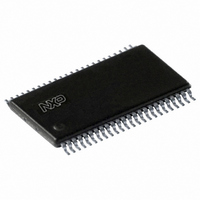SC28L201A1DGG,112 NXP Semiconductors, SC28L201A1DGG,112 Datasheet - Page 14

SC28L201A1DGG,112
Manufacturer Part Number
SC28L201A1DGG,112
Description
IC UART W/FIFO 48-TSSOP
Manufacturer
NXP Semiconductors
Series
IMPACTr
Datasheet
1.SC28L201A1DGG118.pdf
(110 pages)
Specifications of SC28L201A1DGG,112
Features
False-start Bit Detection
Number Of Channels
2, DUART
Fifo's
256 Byte
Voltage - Supply
3.3V, 5V
With Parallel Port
Yes
With Auto Flow Control
Yes
With False Start Bit Detection
Yes
With Modem Control
Yes
With Cmos
Yes
Mounting Type
Surface Mount
Package / Case
48-TSSOP
Lead Free Status / RoHS Status
Lead free / RoHS Compliant
Other names
568-3293-5
935277824112
SC28L201A1DGG
935277824112
SC28L201A1DGG
Philips Semiconductors
9397 750 13138
Product data sheet
7.1.2 IACKN cycle, update CIR
When operating in the 86xxx mode, DACKN is not generated. Data is written on the
termination of CEN or WRN, whichever one occurs first. Read data is presented from the
leading edge of the read condition (CEN and RDN both LOW).
In the 68000 mode, data is written to the registers on the rise of CEN or the fall of DACKN,
whichever one occurs first. Data on a read cycle will become valid with respect to the fall
of CEN. It will always be valid at the fall of DACKN. The bus returns to high-impedance
when either CEN or RDN returns to a logical 1 (HIGH).
(Valid for both interrupt and polled service modes.)
When the host CPU responds to the interrupt, it will usually assert the IACKN signal LOW.
This will cause the intelligent interrupt system of the UART to generate an IACKN cycle in
which the condition of the interrupting source is determined. When IACKN asserts, the
last valid of the interrupt arbitration cycle is captured in the CIR. The value captured
presents all of the important details of the highest priority interrupt at the moment the
IACKN (or the Update CIR command) was asserted. Due to system interrupt latency the
interrupt condition captured by the CIR may not be the condition that caused the initial
assertion of the interrupt. Recall that any number of interrupts can occur at the same time.
Nearly all interrupt events are totally asynchronous to each other and will depend on a
variety of internal or external clocks with various times or being enabled or disabled.
The UART will respond to the IACKN cycle with an interrupt vector. The interrupt vector
may be a fixed value, the content of the Interrupt Vector Register, or when interrupt vector
modification is enabled via ICR, it may contain codes for the interrupt type and/or
interrupting channel. This allows the interrupt vector to steer the interrupt service directly
to the proper service routine. The interrupt value captured in the CIR remains until another
IACKN or Update CIR command is given to the UART. The interrupting channel and
interrupt type fields of the CIR set the current interrupt context of the UART. The channel
component of the interrupt context allows the use of Global Interrupt Information registers
that appear at fixed positions in the register address map. For example, a read of the
Global GIBCR will read the channel FIFO byte count if the CIR interrupt context is the
receiver. At another time read of the GIBCR will show the transmitter byte count if the
interrupt context is that of the transmitter interrupt, and so on. Global registers exist to
facilitate qualifying the interrupt parameters and for writing to and reading from FIFOs
without explicitly addressing them. They are essentially an indirect address to the content
of the CIR.
The CIR will load with 0x00 if IACKN or Update CIR is asserted when the arbitration circuit
is not asserting an interrupt. In this condition there is no arbitration value that exceeds the
threshold value. When Interrupt vector modification is active in this situation the interrupt
vector bits associated with the CIR will all be zero. A zero type field indicates nothing with
in the UART is requiring processor service.
Remark: IACKN is essentially a special read action where the value of the interrupt vector
is presented to the data bus.
Rev. 01 — 31 October 2005
3.3 V, 5 V UART, 3.125 Mbit/s, with 256-byte FIFO
© Koninklijke Philips Electronics N.V. 2005. All rights reserved.
SC28L201
14 of 110















